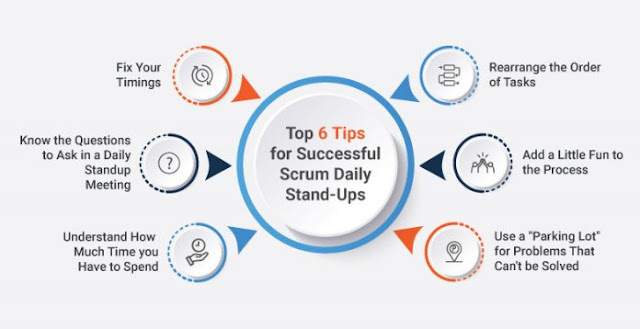Is it easy enough to conduct a daily scrum meeting?
It’s just another meeting, after all. Not actually, that is.
So, what is Scrum Meeting?
The standup or scrum meeting is a delicately nuanced method in which the team is encouraged to stand for the duration of the meeting, typically held for a brief period.
Stand-up is a powerful process that keeps your project moving. But, at the same time, it is also easy for the meeting to turn into one that doesn’t add any value. So, knowing the right way to perform these meetings is important. So, today let us discuss them.
Here are six suggestions to prevent this from happening and help you optimize your daily scrums.
6 Ways to Improve Your Stand-Ups
Scrum call is a little progress every day
The Daily Scrum is the official term. But some call it the daily stand-up, the scrum, the morning meeting, or the huddle.
When done correctly, it is very valuable for the whole Team. However, it can become unbearable when done badly. A chore people don’t want to do.
So, let us point out a few suggestions to improve the daily stand-up.
1. Fix Your Timings
The daily scrum is limited to 15 minutes per day, though it is typically much shorter. If your daily scrum keeps going over, you should investigate why.
It’s not natural to cut someone off in the middle of a conversation, but you should do it if they’re babbling and not contributing anything. Bigger discussions can and should occur, but not during the daily scrum. Keep the daily scrum on track and within the allotted time.
One can add extra time on the fly in 1 or 5-minute increments if you need it for a particular task. To keep everyone on the same page, the timer will send out alerts when it is started, when more time is added, when the time is up, and when the meeting is over.
Although you can use the daily stand-up outside of the Scrum framework, the meeting will be more productive if you limit it to answering only three questions, which we will discuss in the next section of the blog.
2. Know the Questions to Ask in a Daily Standup Meeting
This is one way of conducting the meeting, but there is no prescribed way or format. Scrum merely gives an example of how you could run it. It’s down to the team to run it as they see fit.
Mixing things up occasionally and changing how the team conducts the daily scrum is good. One way is to focus on the Product Backlog Items, starting right to the left and walking the board. This way, every person gets talked about and is noticed. But if the team works well together, work in progress should be addressed, regardless of how you conduct the daily scrum.
During the daily scrum, people discuss which task to perform and who will work on it. In other words, what is the most important task, and who is working on it? Also, transfers are very important if anything is getting in the way of the work on the critical path. You want to keep the ball as you pass it on to the next important task.
The three questions are a common Daily Scrum process that Development Teams tend to follow:
1. What did I do yesterday that helped the team reach the Sprint Goal?
2. How will I help the team reach the Sprint Goal today?
3. Do I see anything that makes it hard for me or the team to reach the Sprint Goal?
Answering these 3 questions will be enough in the daily scrum.
3. Know How Much Time you Have to Spend
The Daily Scrum can happen at any time as long as it happens at the same time and place daily to keep things simple. The exact time can be whenever the team feels like it.
If the goal is to check, plan, and change things for the next 24 hours, the daily scrum should happen as soon as possible. From what I’ve seen, the daily scrum will have a different effect if you do it at 11 a.m. or 1 p.m. The workday has already started, and people will have already talked.
I think you should ask the team when they will be there and then agree on a time that works for everyone. Between 9:15 and 10:15 in the morning is the best time.
Having the daily scrum between these times does help cut down on problems that could happen. For example, if people are late to work because of bad traffic, they probably will get it.
4. Rearrange the Order of Tasks
Everyone wants to do well at what they do. But team members are often too busy with other projects to work independently.
Daily meetings are a good way to ensure priorities are clear and right and move work around.
If a team member is too busy, they might work on the wrong thing, and important tasks might take longer than they should. Use the time during the daily huddle to ensure that everyone on the team knows their top priorities and is relaxed.
5. Add a Little Fun to the Process
Make sure everyone on your team is aware of the stand-up meeting. Due to the limited time, it’s important to stick to a plan, but you could let people know when the session is about to start by playing a happy tune or singing a song. If you work from home, send a daily calendar invite with a fun fact or a thought for the day.
By giving teammates a quick chance to relax with warm-up exercises or “ice breakers,” you create a more cooperative environment and make it easier for people who are usually shy to share their ideas and thoughts about the tasks.
6. Use a “Parking Lot” for Problems that Can’t be Solved
The daily scrum meeting agenda lets everyone on the team know what was done earlier, what needs to be done, and what problems are getting in the way. Anything else needs to be taken care of after these.
Explain what a “parking lot” is and list the things that will be dealt with later. After the meeting is over, set up a new meeting with only those who have something to do with that issue. You could keep a notebook or whiteboard with a list of topics that need a longer discussion and must be taken care of by a certain sub-division.
Team members should be able to use these “parking lots” even when they aren’t at the scrum daily meetings. This is so they can write down things that need to be done. So, during their daily scrum meetings, they can stay on topic and not think about anything else.
Source: invensislearning.com






0 comments:
Post a Comment